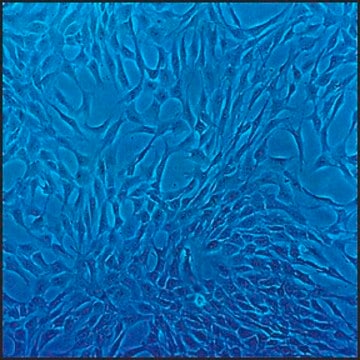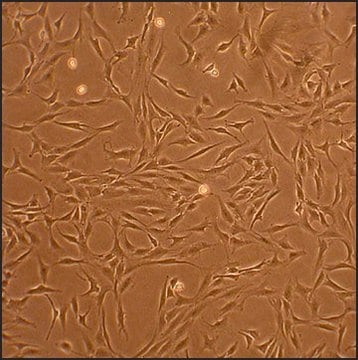408OA-05A
Human Fibroblast-Like Synoviocytes-Osteoarthritis: HFLS-OA, adult
Synonyme(s) :
Human fibroblast culture
About This Item
Produits recommandés
Source biologique
human synovial tissues (osteoarthritic)
Niveau de qualité
Conditionnement
pkg of 500,000 cells
Fabricant/nom de marque
Cell Applications, Inc
Mode de croissance
Adherent
Caryotype
2n = 46
Morphologie
Fibroblast-like
Technique(s)
cell culture | mammalian: suitable
Maladie(s) pertinente(s)
arthritis; coagulation disorders
Conditions d'expédition
dry ice
Température de stockage
−196°C
Catégories apparentées
Description générale
HFLS-RA provide an excellent cellular model for studying synoviocyte physiology in relation to development and treatment of rheumatoid arthritis.
HFLS-RA have been used in numerous research studies to:
- Study signaling pathways implicated in the development of joint inflammation and rheumatoid arthritis (Abe, 2006; Akasaka, 2005; Bai, 2012; Fan, 2013; Furuhashi, 2008; Hashizume, 2008; Matsuyama, 2010; Tsuji, 1999; Yamaguch, 2012a,b; Yano, 2001)
- Evaluate possible contribution of EBV to nonresolving rheumatoid arthritis inflammation through inducing IL-6 production by synoviocytes (Chiu, 2013)
- Evaluate the anti-inflammatory and antirheumatic activity of various compounds, such as celastrol (Venkatesha, 2011; Xu, 2013), triptolide (Kong, 2013; Lin, 2013), arsenic trioxide (Mei, 2011), Wen Luo Yin (Liu, 2013), bucillamine (Tsuji, 2007), therapeutic lyposomes (Harigai, 2007; Ichihara, 2011; Matsumoto, 2013; Negishi, 2011), anti-IL-6R and anti-CD319 antibodies (Suzuki, 2010; Woo, 2013), as well as inhibitors of NF-κB (Baima, 2010; Keith, 2005), methionine aminopeptidase-2 (Bernier, 2004), Tpl2 (Hall, 2007), aryl hydrocarbon receptor (Lahoti, 2013) and p38 MAP kinase (Wada, 2005); and additionally demonstrate the beneficial anti-inflammatory effects of low level light therapy (Yamaura, 2009)
- Investigate the causes of metalloproteinases induction in patients with Lyme disease-associated arthritis (Lin, 2001)
- Develop adenovirus-based siRNA delivery system (Arts, 2003)
Additionally, together with normal HFLS, HFLS-RA were used to:
- Identify causing agents (such as uric acid crystals or platelet microparticles) and study the immunopathological mechanisms and signal transduction pathways leading to joint inflammation in rheumatoid arthritis (Chen, 2011a; Hsu, 2012; Mathieu, 2008; Tsuji, 2012), and to demonstrate the role of estrogen signaling in increasing inflammation (Galal, 2008)
- Investigate anti-inflammatory properties of herbal compound Sinomenine suggested for rheumatoid arthritis treatment (Chen, 2011b)
- Study the effects of extracellular matrix composition on cell attachment and migration relevant to T-cell function in inflamed tissues (Evanko, 2012)
In parallel with HFLS isolated from joints of patients with osteoarthritis HFLS-RA were used in a study demonstrating the involvement of capsid proteins of parvorvirus B19 in activating synoviocyte migration and induction of the inflammatory response leading to acute symmetrical polyarthropathy (Lu, 2006).
Finally, all three types of HFLS (normal, RA and OA) were used to investigate the role of human endogenous retroviruses (HERVs) in development of rheumatoid arthritis, and suggest that activated expression of different forms of HERV contribute to development of rheumatoid arthritis symptoms by different mechanisms (Freimanis, 2010).
Origine de la lignée cellulaire
Application
Composants
Notes préparatoires
- 2nd passage, >500,000 cells in Basal Medium containing 10% FBS & 10% DMSO
- Can be cultured at least 5 doublings
Procédure de repiquage
Clause de non-responsabilité
Code de la classe de stockage
11 - Combustible Solids
Classe de danger pour l'eau (WGK)
WGK 3
Point d'éclair (°F)
Not applicable
Point d'éclair (°C)
Not applicable
Certificats d'analyse (COA)
Recherchez un Certificats d'analyse (COA) en saisissant le numéro de lot du produit. Les numéros de lot figurent sur l'étiquette du produit après les mots "Lot" ou "Batch".
Déjà en possession de ce produit ?
Retrouvez la documentation relative aux produits que vous avez récemment achetés dans la Bibliothèque de documents.
Les clients ont également consulté
Notre équipe de scientifiques dispose d'une expérience dans tous les secteurs de la recherche, notamment en sciences de la vie, science des matériaux, synthèse chimique, chromatographie, analyse et dans de nombreux autres domaines..
Contacter notre Service technique









